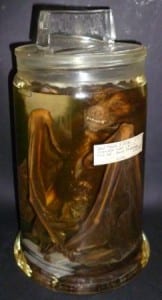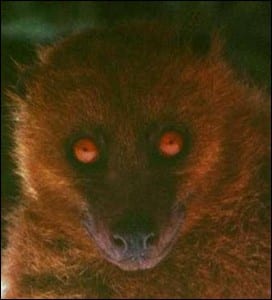Specimen of the Week: Week Twenty-Eight
By Emma-Louise Nicholls, on 23 April 2012
 Ever heard of the chicken frog? What about the tiger shark? If I asked you what these species plus, say, the turtle dove and the spider monkey had in common, what would you say? Well, there are probably quite a few things when you dig deep (they all have eyes, for example), but superficially, it’s all in the name. Or nameS, as it were. This week’s specimen of the week has an equally split personality, as it is…
Ever heard of the chicken frog? What about the tiger shark? If I asked you what these species plus, say, the turtle dove and the spider monkey had in common, what would you say? Well, there are probably quite a few things when you dig deep (they all have eyes, for example), but superficially, it’s all in the name. Or nameS, as it were. This week’s specimen of the week has an equally split personality, as it is…
**!!!The Monkey-Faced Bat!!!**
1) Every single species of monkey-faced bat is found on one or more island within the island chain of the Solomon Islands. Writing it like that makes the Solomon Islands sound like a big place. It isn’t. They are found nowhere else in the world. Monkey-faced bats… not islands.
2) Picky about countries, and picky about habitats. Monkey-faced bats are found in all types of rainforest but are less impressed by agricultural land which is unfortunately sweeping over the rainforest in a Fern Gully (great film for the weekend) style large-scale conversion of forest habitat by humans.
3) Two of the five species of this bat group were only discovered in the year 2000.
4) The monkey-faced bats (that makes me smile each time I write it) are hunted by local folk for food. Unfortunately however, the locals tend to use an aggressive hunting technique that involves burning the trees down. This smokes the bat out but also destroys the roosting sites for other bats.
5) Monkey-faced bats belong to the bat subgroup called Megachiroptera. This group have large eyes and small ears as they use sight to find fruit, their main food type. The other group is the Microchiroptera which have small eyes and massive ears. This is because they are predators that hunt using echolocation. These species also have a nose leaf of varying sizes and shapes. If I were a bat, I would have an epic sized one like this yellow-winged bat for example. Just FYI.
Our MFB lives with our other bats in cabinet 18. Come brave the rain and say hey!
2 Responses to “Specimen of the Week: Week Twenty-Eight”
- 1
-
2
Tree Frog Man wrote on 6 May 2012:
Spooky, The monkey at the top looks like something from a scary movie.
 Close
Close




Monkey faced bats – were they those critters in The Wizard of Oz?!
Goodness me! – did you know there is a plant called Cuphea llavea, the ‘Bat-faced monkey’ flower?!
http://www.mexicohorse.com/wildflower_study.htm